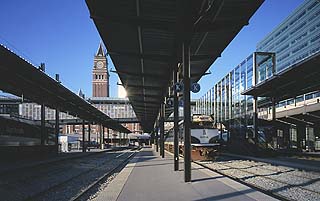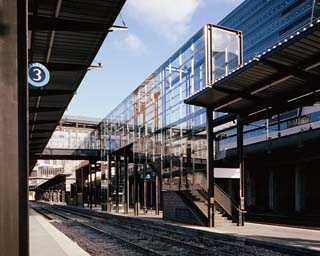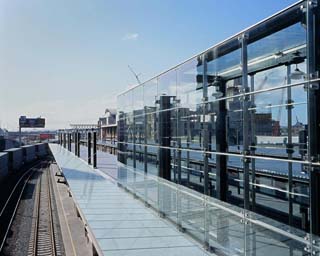|
Subscribe / Renew |
|
|
Contact Us |
|
| ► Subscribe to our Free Weekly Newsletter | |
| home | Welcome, sign in or click here to subscribe. | login |
Architecture & Engineering
| |
November 6, 2002
Transparent design helps keep commuters moving
Special to the Journal

Photo by Art Grice Otak’s “transparent design” of the King Street Station allows commuters to see the rail yard in the foreground and the skyline beyond. The canopies are glazed for weather protection. |
Commuters are like a force of nature, their daily rhythms set in synchronous motion with each other and the modality of travel. As they ebb and flow, we’re reminded that the city is alive and working.
Like a rising tide, Sounder commuters are increasing exponentially, attracted to the ease and traditional comforts of rail. Since opening in September of 2000, the area’s new commuter rail line between Seattle and Tacoma has increased ridership to between 2,500 and 3,000 per day. The weekly ridership is approximately 14,000.

Photo by Clair Enlow Architect David Clinkston of Otak at the top of the “wafer.”
|
Meeting on-time targets has spurred the increase, and a beautifully simple system of bridges, platforms, canopies and screens designed by Otak, in association with DKA, works hard to make the commute an easy and pleasant part of the day.
"Transparent design" is the term adopted to identify the King Street Station platforms and canopies, a project both complex in scope and simple in concept. It was honored last year with a commendation from the Honor Awards for Washington Architecture, sponsored by the Seattle Chapter of the American Institute of Architects.
Nicknamed "the wafer," the thin, three-story-high, glass-paneled steel structures that enclose the stairways to the platform seem to shoot through the equally high, perpendicular Weller Street Bridge like a boxed beam of light. The wafers rise one story above street level, marking the presence of Sounder rail from Jackson Street and the Fourth Avenue extension.
|
King Street Station platforms and canopies for Sound Transit Commuter Rail and Amtrak |
|
Otak, Inc. in association with Donald King Associates Owners: Sound Transit, Amtrak and WSDOT Rail Division Project type: Transit Completion date: September 2000 Construction cost: $7 million Structural engineer: Swenson Say Faget Electrical engineer: Interface Engineers Mechanical engineer: Berona Engineers Lighting design: J. Miller Associates Construction Management: O'Brien Krietzberg Commuter Rail Public Art: Ned Kahn General contractor: C.A. Carey Corp. The clarity of the design, simple understandable parts, visually apparent circulation path and means, and vertical circulation that can be seen all lend to its wayfinding success. Transparency and clear sightlines help provide a sense of security for users. Hopefully, the system will 'stitch itself' into the station once the station is renovated. This project is a great addition to the transit system of the region. This is only half a project without the renovation of the station itself, but the transparency, materials and simple structural language provide a strong, clear direction for the rest of the job. King Street Station is simple and well detailed, the translucent station is the right addition to its context. The glazing allows weather protection, way-finding and a feeling of security for rail passengers. |
Commuters enter at both ends of the Weller Street Bridge and at another glass-enclosed entrance just north of Jackson, walking through the structures at a rate of over 2,000 per hour during the rush, descending the stairs to the platform to disappear into the glowing light of the train cars. Frame by frame, they flow past the glass panels of the balconies and stairs like a video of urban life in real time.
From inside, commuters can see the rail yard in the foreground and the skyline beyond, always aware of their own position and the activity anywhere within the complex of bridge, passages and platforms. Looking through the end of the wafer as they descend the stair, they are treated to a framed view of the city beyond. As they reach the platform, they have a clear view of surrounding trains, tracks and people.
While the canopies accommodate both Sounder and Amtrak passengers, the challenge of the project was to bring commuters in and out of a rail yard without commingling them with Amtrak patrons on one side and Burlington Northern double-stacked freight cars on the other. Separating commuters from tourists was one of the keys to growing ridership, according to David Beal, program manager for Sounder.
The challenge, according to project designer David Clinkston of Otak, is to move people in and out comfortably, and also to make good use of a really confusing urban space.
Around Seattle’s developing multi-modal transit center at King Street Sttion, there are a lot of holes in the urban fabric. The Fourth Avenue extension viaduct sweeps past historic King Street Station and the tracks below. Beyond the tracks lies the vast parking lot north of the new football stadium. Passengers making connections must negotiate the transition from street to rail platform and back.
The project brings another dance partner into a crowded urban room, said Clinkston. Sounder passengers must mix it up with passenger rail, future light rail and heavy-duty freight trains -- all adjacent to a historic building.
The simple, transparent stairway and balcony structures and the high, glass-paneled balconies all help to make it an exciting but compatible addition.
"It blends well into the surroundings and it seems like it’s always been there," said Bill Looney, a rail commuter, commenting on the project.
The glass and steel wafers that rise above the grade of Jackson and Fourth Avenue help to restore the edge of the street. At the same time, they melt into a diverse urban mix of industrial, historic and high-rise.
"Keep it complimentary, keep it simple," said Donald King of DKA, a design partner on the project.

Photo by Otak The canopies accommodate Sounder and Amtrak passengers, but the challenge for designers was moving commuters in and out without mixing them with Amtrak passengers. |
But getting there was not a simple task. Before the design team began, they studied commuters and found that their needs are few, but absolute. Unlike the users of Amtrak, who have an entire station in which to wait before they travel, commuters typically arrive minutes before departure and don’t need toilet facilities at the station. In addition to safe access to the train, all they need is shelter from the rain and the wind and perhaps a place to lean and read.
And accommodating these simple needs was a tight fit. Amtrak, Sounder and Burlington Northern freight trains run side-by-side in close proximity. The platforms between are narrow, making it difficult to provide a central stair with circulation on both sides. On top of that, the canopies that provide the only weather shelter have to clear the track with enough height to accommodate a double-decker freight train, just in case Burlington Northern decides to exercise its option for running freight on the Sounder line.
As a result, the 6-foot-wide stairs land at the side of the platform, just outside of the clearance for the track. Descending on either side of the Weller Street Bridge and also from the landing north of Jackson, they’re enclosed with a rigid, post-and-beam main frame and a second glass-panelled frame hanging from the main structure. Canopies are cantilevered from the steel columns that extend along the platforms, supported by compression struts and by perpendicular beams. Visible from the street, a field of columns and beam-supporting cables rises above the glass-edged canopies.

Photo by Art Grice The materials -- steel, stainless steel, anodized aluminum, glass and concrete -- were chosen to hold up to weather and infrequent maintenance. |
The entire system -- stairways, canopies and amenities follows a thin, linear pattern along the platform devoted to Sounder trains, a pattern repeated in the canopies on the Amtrak platform. The steel structure is divided into alternating bays of 30 feet and 10 feet. Ticket vending machines and passenger amenities such as information panels, glass windscreens and precast concrete lean rails are all built into the 10-foot bays with seamless simplicity. The alternating 30-foot bays provide maneuvering room for passengers crossing the platform and boarding trains.
The materials -- steel, stainless steel, anodized aluminum, glass and concrete -- were chosen to hold up to the weather and to infrequent maintenance. In fact, the facility has not been cleaned since it opened in the fall of 2000.
Safety, visibility and durability make it a success story in a region and a nation working hard to offer commuters alternatives to crowded roads.
Clair Enlow can be reached by e-mail at clair@clairenlow.com.
Previous columns:
- Breaking out of the box, Northwest style, 10-02-2002
- At BCC, a study in sustainable design, 09-04-2002
- A retreat for teens ends decade-long run-around, 08-07-2002
- A once lackluster hall now scans the heavens, 07-03-2002
- Design team got a workout at Hec Ed, 06-05-2002
- A terra cotta shell for intimate dining, 05-01-2002
- Serious, modern City Hall, with a friendly barn door, 04-03-2002
- Tiny Mercer Island chapel solves a small, tricky problem, 03-06-2002


